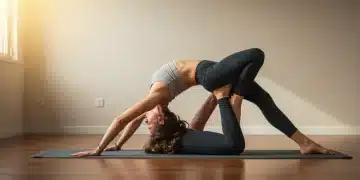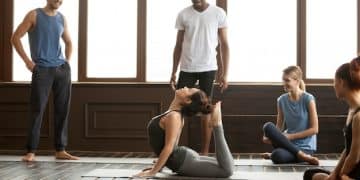Unlock Deeper Stretches: Yoga Straps for 10% More Flexibility
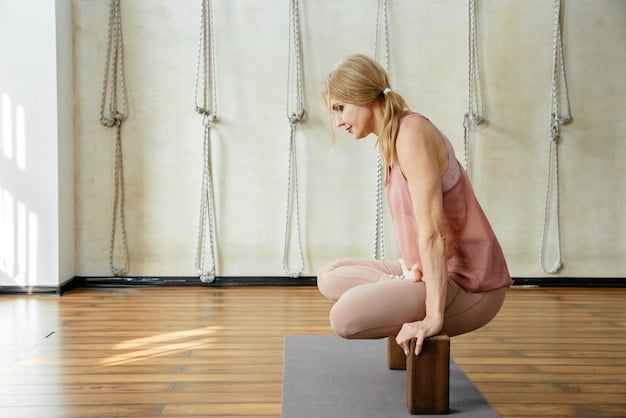
Unlock Deeper Stretches: Insider Tips for Using Yoga Straps to Increase Range of Motion by 10% explores how yoga straps can significantly enhance flexibility and deepen your yoga practice, providing support and allowing for greater reach in various poses.
Want to achieve deeper stretches and improve your flexibility in yoga? Discover insider tips on using yoga straps to increase range of motion by 10%, making your practice more effective and accessible.
Understanding the Basics of Yoga Straps
Yoga straps are simple yet versatile props that can greatly enhance your yoga practice. They primarily help bridge the gap when flexibility is limited, allowing you to perform poses with proper alignment and gradually increase your range of motion.
Let’s delve into what makes yoga straps so essential and how they contribute to a safer and more effective workout.
Why Use a Yoga Strap?
Yoga straps provide assistance in poses where you might not be able to reach your hands or feet. They help maintain correct form, reduce strain, and allow you to focus on the intended stretch. This is particularly useful for beginners or individuals with limited flexibility.
- Improved Alignment: Straps help you maintain proper alignment in poses, reducing the risk of injury.
- Enhanced Reach: They extend your reach, allowing you to access poses that might otherwise be inaccessible.
- Gradual Progression: Straps allow you to progressively deepen stretches over time.
Yoga straps are not just for beginners. Experienced practitioners also use them to refine their alignment and explore new variations of poses.
Choosing the Right Yoga Strap
Selecting the right yoga strap can significantly impact your practice. Factors such as material, length, and buckle type play crucial roles. Let’s look at the essential aspects to consider when purchasing a yoga strap.
Getting the perfect strap for your needs is about finding the right balance between comfort, durability, and ease of use.
Material Matters
Yoga straps are typically made from cotton, nylon, or a blend of both. Cotton straps are softer and more comfortable, while nylon straps are more durable and offer greater support. Consider your personal preferences and the intensity of your practice when choosing the material.
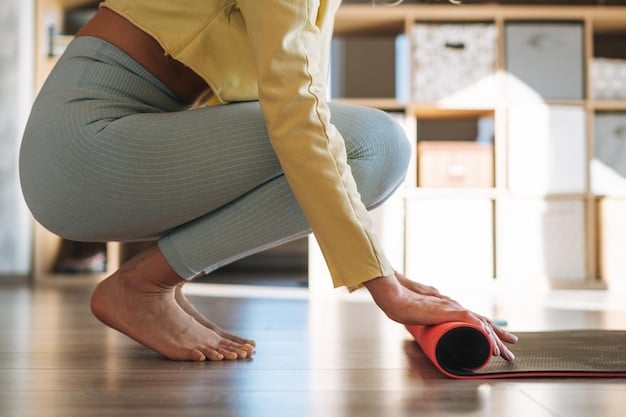
Length and Buckle Type
The length of your yoga strap should be appropriate for your height and flexibility. A standard length is around 6 to 8 feet. Buckle types vary as well, with D-ring buckles being the most common. These are easy to adjust and provide a secure hold.
- Standard Length: 6-8 feet is suitable for most people.
- D-Ring Buckles: These are easy to adjust and provide a secure hold.
- Consider Your Height: Taller individuals may prefer a longer strap.
Always test the buckle before using the strap to ensure it holds securely and doesn’t slip during your poses.
Essential Yoga Poses Enhanced by Straps
Yoga straps can transform your practice by making various challenging poses more accessible. They can help deepen stretches, improve alignment, and build strength. Let’s explore a few beneficial yoga poses that benefit most from straps.
Straps allow you to experience these poses in a more aligned and supported way, leading to greater benefits.
Seated Forward Fold (Paschimottanasana)
In Paschimottanasana, a yoga strap can help you reach your feet while maintaining a straight spine. Loop the strap around the soles of your feet, holding the ends with your hands. Gently pull to deepen the stretch while keeping your back straight.
Cow Face Pose (Gomukhasana)
This pose can be challenging for those with tight shoulders. Use a strap to connect your hands behind your back. Hold one end of the strap overhead and let the other hang down your back. Reach your lower hand behind your back and grab the strap to gradually walk your hands closer together.
- Improved Shoulder Opening: Helps open up tight shoulders.
- Gradual Progression: Allows you to slowly increase the stretch over time.
- Alternative Option: This pose can be modified to your current flexibility level.
Always listen to your body and avoid pushing yourself too far. The goal is to feel a gentle stretch, not pain.
Advanced Techniques for Deeper Stretches
Once you are comfortable with the basic uses of yoga straps, you can explore more advanced techniques to deepen your stretches even further. These techniques focus on enhancing your control, stability, and overall flexibility.
These advanced techniques require mindful practice and attention to your body, ensuring you stay safe and effective.
Using Straps for Spinal Extension
Yoga straps can provide support and stability during spinal extensions. For example, in poses like Camel Pose (Ustrasana), a strap around your thighs can help maintain proper alignment and prevent overextension in the lower back. This support allows you to focus on opening the chest and lengthening the spine.
Deepening Hamstring Stretches
To deepen hamstring stretches, use a strap in poses like Reclining Hand-to-Big-Toe Pose (Supta Padangusthasana). Lie on your back, loop the strap around the ball of one foot, and extend the leg straight up towards the ceiling. The strap helps maintain the leg’s position, allowing for a deeper, more effective stretch in the hamstrings.
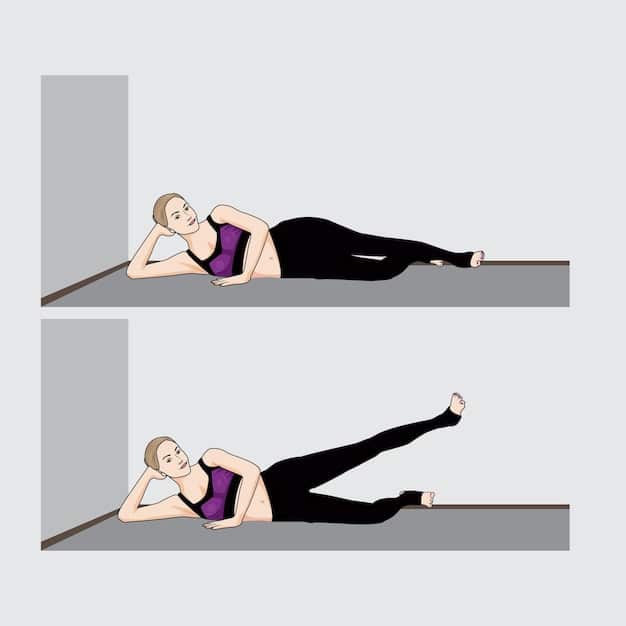
- Enhanced Control: Facilitates better control over your movements.
- Increased Stability: Provides stability during challenging poses.
- Improved Flexibility: Gradually increases your range of motion.
Remember to engage your core muscles to protect your lower back and avoid any jerky movements. Slow, controlled movements are key to preventing injuries.
Common Mistakes to Avoid When Using Yoga Straps
While yoga straps are invaluable tools, it’s crucial to use them correctly to avoid injuries and maximize their benefits. Many beginners and even experienced practitioners make common mistakes. Be mindful of these to ensure your practice is safe and effective.
Avoiding these common mistakes can significantly improve your yoga experience.
Over-reliance on the Strap
One of the biggest mistakes is becoming overly dependent on the strap. While it’s there to assist you, it shouldn’t become a crutch that prevents you from engaging your muscles. Focus on gradually reducing your reliance on the strap as your flexibility improves.
Improper Strap Placement
Incorrect strap placement can lead to ineffective stretches and potential injuries. Ensure that the strap is positioned correctly around your feet, hands, or other body parts as instructed for each pose. If you’re unsure, consult with a yoga instructor.
Using a strap without proper guidance is like using any tool without instruction—avoid common mistakes by being mindful of your form and listening to your body.
Integrating Yoga Straps into Your Daily Routine
Incorporating yoga straps into your daily routine can have a profound impact on your flexibility and overall well-being. Consistent practice, even for just a few minutes each day, can lead to noticeable improvements in your range of motion and body awareness.
Regular practice with yoga straps can transform your physical and mental health.
Morning Stretches with a Strap
Start your day with a few simple stretches using a yoga strap. Seated forward folds and hamstring stretches are great ways to gently awaken your muscles and increase circulation. This can help reduce stiffness and prepare your body for the day ahead.
Evening Relaxation Techniques
Use a strap in the evening to release tension and promote relaxation. Reclining poses with a strap can help soothe tired muscles and calm your mind. Incorporating these into your bedtime routine can improve sleep quality.
Make yoga straps a consistent part of your daily life to enjoy their full range of benefits, including improved flexibility, reduced stress, and enhanced body awareness.
Here’s a summary table highlighting the key aspects discussed in the article:
| Key Point | Brief Description |
|---|---|
| 💪 Enhanced Flexibility | Yoga straps increase range of motion in various poses. |
| 🧘 Proper Alignment | Straps help maintain correct posture, reducing strain and injury risk. |
| 🎯 Target Poses | Ideal for seated forward folds and cow face pose. |
| 🚫 Avoid Over-Reliance | Focus on gradually reducing strap use as flexibility improves. |
Frequently Asked Questions
▼
The ideal length is typically between 6 and 8 feet. This length accommodates various body sizes and allows for versatility in different yoga poses, ensuring proper support and reach.
▼
Yes, by promoting proper alignment and preventing overstretching, yoga straps can significantly reduce the risk of injuries. They provide support, allowing for controlled movements within a safe range.
▼
For optimal results, incorporate yoga straps into your daily routine. Regular, consistent use allows for gradual improvements in flexibility and overall strength. Even short daily sessions can be beneficial.
▼
Yoga straps are particularly useful in poses like seated forward folds, hamstring stretches, and cow face pose. These poses benefit from the added reach and support provided by the strap.
▼
Yes, yoga straps are suitable for all fitness levels. They are particularly beneficial for beginners, helping them achieve proper alignment and gradually improve flexibility. Advanced practitioners can also use them to refine techniques.
Conclusion
Incorporating yoga straps to increase range of motion by 10% can transform your yoga practice, offering enhanced support, improved alignment, and greater flexibility. By understanding the basics, choosing the right strap, and avoiding common mistakes, you can unlock deeper stretches and reap the full benefits of this versatile prop.

